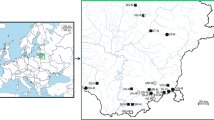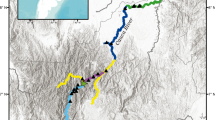Abstract
During the last 200 years, the riparianecosystem along major rivers has been reducedto a few scattered remnants. Important elementsof the riparian ecosystem are water bodieswhich were originally connected to the mainriver channel by annual floodings. Due to riverregulations many of these remnants are nowvirtually isolated. In an allozyme analysisusing roach, Rutilus rutilus, as a studyspecies we demonstrate that the geneticdiversity (number of alleles per locus,expected heterozygosity) of populations livingwithin floodplain water bodies is not severelyimpoverished compared to the genetic diversitywithin the main river channel. However, wefound slight differences in the allelefrequencies of flood plain water bodies and themain river channel. Nevertheless, fishpopulations in floodplain water bodies mayserve as reservoirs of autochthonous geneticmaterial for restoration of fish populations inthe main river channel after populationextinction due to catastrophic accidents (e.g.industrial pollution).
Similar content being viewed by others
References
Baade U, Fredrich F (1998) Movement and pattern of activity of the roach in the River Spree, Germany. J. Fish Biol., 52, 1165–1174.
Banarescu P (1991) Zoogeography of fresh waters. Vol. 2. Distribution and Dispersal of Freshwater Animals in North America and Eurasia. Aula Verlag, Wiesbaden.
Belkhir K, Borsa P, Goudet J, Chikli L, Bonhomme F (2000) GENETIX, logiciel sous WindowsTM pour la génétique des populations, version 4.01. University of Montpellier II, Montpellier.
Bernatchez L, Chouinard A, Lu GQ (1999) Integrating molecular genetics and ecology in studies of adaptive radiation: Whitefish, Coregonus sp., as a case study. 68, 173–194.
Bornette G, Amoros C, Lamouroux N (1998) Aquatic plant diversity in riverine wetlands: The role of connectivity. Freshwater Biol., 39, 267–283.
Bouvet Y, Bobin M, Maslin JL, Pattee E (1995) The genetic structure of roach populations in two contrasted large rivers. Hydrobiologia, 303, 229–234.
Bouvet Y, Soewardi K, Pattee E (1991) The discrimination of roach Rutilus rutilus (Linnaeus, 1758) populations in different parts of a river system. An investigation using biochemical markers. Hydrobiologia, 209, 161–167.
Brauckmann U, Jöchle G, Pinter I, Schmitz W, Vobis H (1987) Der ökologische Zustand des Rheins nach dem Sandoz-Unfall. Landesamt für Umweltschutz, Institut fur Wasser und Abfallwirtschaft, Bonn.
Bravard JP, Amoros C, Pautou C (1986) Impact of civil engineering works on the successions of communities in a fluvial system: A methodological and predictive approach applied to a section of the Upper Rhone. Oikos, 47, 92–111.
Brookes A (1988) Channelised Rivers: Perspectives for Environmental Management. John Wiley & Sons, Inc., Chichester.
Carvalho G (1993) Evolutionary aspects of fish distribution: Genetic variability and adaptation. J. Fish Biol., 43, 53–73.
Carvalho GR, van Oosterhout C, Hauser L, Magurran AE (2003) Measuring genetic variation in wild populations: From molecular markers to adaptive traits. In: Genes in the Environment (eds. Hails AS, Beringer JE, Godfray HCJ). Blackwell Science Ltd, Oxford, UK.
Cornuet JM, Luikart G (1996) Description and power analysis of two tests for detecting recent population bottlenecks from allele frequency data. Genetics, 144, 2001–2014.
Felsenstein J (1993) PHYLIP (Phylogeny Inference Package), version 3.5c. Department of Genetics, University ofWashington, Seattle.
Frankham R (1996) Relationship of genetic variation to population size in wildlife. Cons. Biol., 10, 1500–1508.
Frankham R, Ballou JD, Briscoe DA (2002) Introduction to Conservation Genetics. Cambridge University Press, Cambridge.
Gillespie RB, Guttmann SI (1989) Effects of contaminants on the frequency of allozymes in populations of the central stoneroller. Environ. Toxicol. Chem., 8, 309–317.
Hänfling B, Brandl R (1998a) Genetic and morphological variation in a common European cyprinid, Leuciscus cephalus within and across central European drainages. J. Fish Biol., 52, 706–715.
Hänfling B, Brandl R (1998b) Genetic differentiation of the bullhead Cottus gobio L. across watersheds in central Europe: Evidence for two taxa. Heredity, 80, 110–117.
Hänfling B, Brandl R (1998c) Genetic variability, population size and isolation of distinct populations in the freshwater fish Cottus gobio L. Mol. Ecol., 7, 1625–1632.
Heithaus MR, Laushman RH (1997) Genetic variation and conservation of stream fishes: Influence of ecology, life history and water quality. Can. J. Fish. Aqu. Sci., 54, 1822–1836.
Hillis DM, Moritz C, Mable BK (1996) Molecular Systematics. Sinauer Associates, Inc., Sunderland, MA, p. 655.
Hindar K, Ryman N, Utter F (1991) Genetic effects of cultured fish on natural fish populations. Can. J. Fish. Aquat. Sci., 48, 945–957.
Ladiges W, Vogt D (1979) Die Süßwasserfische Europas. Bis zum Ural und Kaspischen Meer. Paul Parey Verlag, Hamburg.
Laikre L, Ryman N (1996) Effects on intraspecific biodiversity from harvesting and enhancing natural populations. Ambio, 25, 504–509.
Maitland PS, Lyle AA (1990) Practical conservation of British fishes: Current action on six declining species. J. Fish. Biol., 37A, 255–256.
Maitland PS, Morgan NC (1997) Conservation Management of Freshwater Habitats. Lakes, Rivers and Wetlands. Chapman & Hall, London.
Manly BFJ (1997) RT, a Program for Randomization Testing, version 2.1. West-Inc., Cheyenne/Wyoming.
Mitsch WJ, Gosselink JG (2000) Wetlands, 3rd edn. John Wiley & Sons, Inc., New York.
Mitton JB, Koehn RK (1975) Genetic organisation and adaptive response of allozymes to ecological variables in Fundulus heteroclitus. Genetics, 79, 97–111.
Nei M (1978) Estimation of average heterozygosity and genetic distance from a small number of individuals. Genetics, 89, 583–590.
Petts GE (1990) Forested river corridors: A lost resource. In: Water, Engineering and Landscape (eds. Cosgrove D, Petts GE), pp. 12–34. Belhaven Press, London.
Place AR, Powers DA (1979) Genetic variation and relative catalytic efficiencies: Lactate dehydrogenase B allozymes of Fundulus heteroclitus. Proc. Nat. Acad. Sci. U.S.A., 76, 2354–2358.
Raymond M, Rousset F (1995) GENEPOP (version 1.2): A population genetic software for exact tests and ecumenicism. J. Hered., 86, 248–249.
Reed DH, Frankham R (2001) How closely correlated are molecular and quantitative measures of genetic variation? A meta-analysis. Evolution, 55, 1095–1103.
Reed DH, Frankham R (2003) Correlation between fitness and genetic diversity. Conserv. Biol., 17, 230–237.
Ryman N, Utter F, Laikre L (1995) Protection of intraspecific biodiversity of exploited fishes. Rev. Fish. Biol. Fisher., 5, 417–446.
Salyi G, Csaba G, Darin EG, Orosz E, Lang M, Majoros G, Kunsagi Z, Niklesz C (2000) Effect of thr cyanide and heavy metal pollution passed in the river Szamos and Tisza on the aquatic flora and fauna with special regard to the fish. Magyar Allatrvosok Lapja, 122, 493–497.
Schneider S, Kueffer JM, Roessli D, Excoffier L (2000) Arlequin, a Software for Population Genetic Data Analysis, version 2.0. University of Geneva, Geneva.
Selander RK, Smith MH, Young SY, Johnson WE, Gentry JB (1971) Biochemical polymorphism and systematics in the genus Peromyscus. Univ. Texas Pub., 7103, 49–90.
Shaklee LB, Allendorf FW, Morizot DC, Whitt GS (1990) Gene nomenclature for protein-coding loci in fish. T. Am. Fish. Soc., 119, 2–15.
Slatkin M (1993) Isolation by distance in equilibrium and nonequilibrium populations. Evolution, 39, 53–65.
Toner M, Keddy P (1997) River hydrology and riparian wetlands: A predictive model for ecological assembly. Ecol. Appl., 7, 236–246.
Trockner K, Schiemer F (1997) Ecological aspects of the restoration strategy for a river-floodplain system on the river Danube in Austria. Global Ecol. Biogeogr., 6, 321–329.
Vrijenhoek RC (1998) Conservation genetics of freshwater fish. J. Fish. Biol., 53, 394–412.
Ward RD, Woodwark M, Skibinski DOF (1994) A comparison of genetic diversity levels in marine, freshwater and anadromous fish. J. Fish. Biol., 44, 213–232.
Weigers EL, Zinke A, Gurtzweiler K (1990) Present situation of the European floodplain forests. Forest Ecol. Manag., 33/34, 5–12.
Weir BS, Cockerham CC (1984) Estimating F-statistics for the analysis of population structure. Evolution, 38, 1358–1370.
Wolter C (1999) Comparison of intraspecific variability in four common cyprinids, Abramis brama, Abramis bjoerkna, Rutilus rutilus and Scardinius erythrophthalmus, within and between lowland river systems. Hydrobiologia, 394, 163–177.
Wolter C, Bischoff A, Tautenhahn M, Vilcinkas A (1999) The fish assemblage of the Lower Oder Valley: Species composition, abundances, stock development and fish ecological importance of the polder areas. In: Das Untere Odertal. Auswirkung der periodischen Ñberschwemmungen auf Biozönosen und Arten (eds. Dohle W, Bornkamm R, Weigmann G). Schweizerbart'sche Verlagsbuchhandlung, Stuttgart.
Author information
Authors and Affiliations
Corresponding author
Rights and permissions
About this article
Cite this article
Hänfling, B., Durka, W. & Brandl, R. Impact of habitat fragmentation on genetic population structure of roach, Rutilus rutilus, in a riparian ecosystem. Conservation Genetics 5, 247–257 (2004). https://doi.org/10.1023/B:COGE.0000030008.20492.2c
Issue Date:
DOI: https://doi.org/10.1023/B:COGE.0000030008.20492.2c




